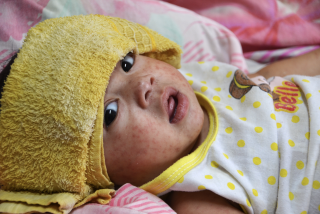Diseases Without Borders
- Share via
As if the world didn’t have enough to worry about, a mysterious and sometimes deadly illness thought to be related to a virus that causes measles in people and distemper in dogs has spread around the globe in recent weeks.
New Zealand Prime Minister Helen Clark raised the level of worry Monday when she warned that the pathogen, called severe acute respiratory distress syndrome, “might rival” the 1918 flu pandemic that killed up to 40 million people. In fact, there are only four confirmed deaths so far -- two in Canada, one in Hong Kong and one in Vietnam -- and five possible deaths in China, which has not yet disclosed test results in the cases.
Another reason for optimism is global disease monitoring. The Centers for Disease Control and Prevention set up a state-of-the-art emergency operations center after the 2001 anthrax attacks. The system proved itself last year, using computer mapping to rapidly alert cities and counties after the West Nile virus began spreading from New York to 39 states, including California. On Friday, the CDC reactivated the center to track the disease, which is characterized by a high fever, dry cough and, in severe cases, breathing difficulty.
International health monitoring still needs beefing up to keep pace with disease risks not only from threats of bioterrorism but from the ease and speed of air travel and the growth of cities, which are still infectious disease incubators.
On Tuesday, the Institute of Medicine, a scientific group that Congress set up to advise on health policy, coincidentally released a report, “Microbial Threats to Health,” that provides a blueprint for improvements. Key among them: prohibiting antibiotic use to promote animal growth -- a practice that incubates drug-resistant super-bugs -- and requiring hospital and commercial medical labs to automatically report infectious disease outbreaks.
The Institute of Medicine report also scolds drug companies and government researchers. Despite the rapid spread of infectious diseases worldwide, its authors write, “we appear less able (or willing) to develop new antimicrobials and vaccines than once was the case, especially for infectious diseases that affect developing countries disproportionately.”
The apparent spread of the new disease from the impoverished Chinese province of Guangdong to privileged suburbs in nations such as Australia, Canada and Germany is the clearest illustration yet of why wealthy nations can’t protect their own citizens unless they help others.






